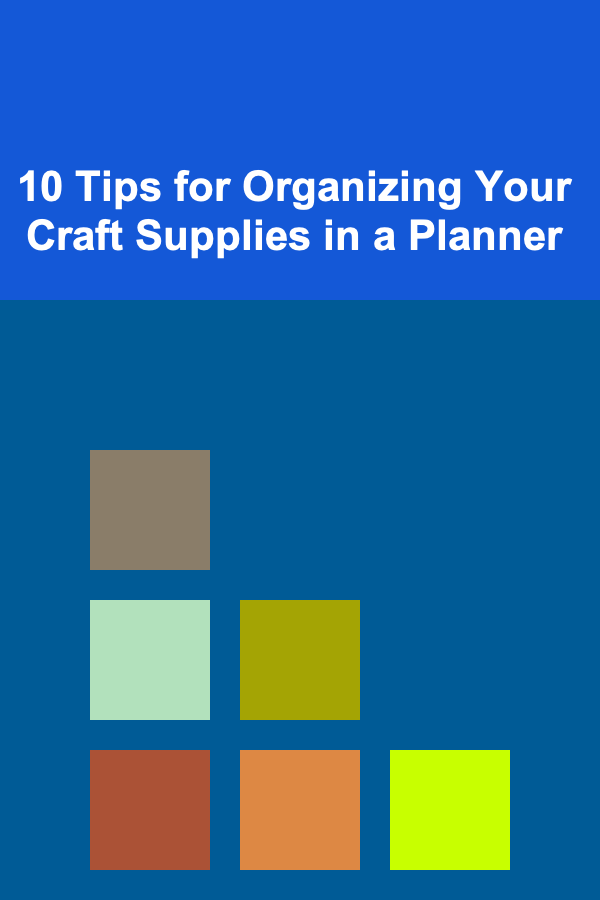
10 Tips for Organizing Your Craft Supplies in a Planner
ebook include PDF & Audio bundle (Micro Guide)
$12.99$7.99
Limited Time Offer! Order within the next:

Crafting is a wonderful hobby that allows individuals to express creativity, unwind, and create beautiful handmade items. However, keeping craft supplies organized can sometimes be challenging, especially if you have an extensive collection of materials. Whether you're a scrapbooker, card maker, knitter, or general crafter, having a system in place to organize your supplies is crucial to maintain efficiency and creativity.
One highly effective tool for organizing your craft supplies is a planner. While planners are typically used for scheduling, they can be a perfect solution for organizing your craft materials, ideas, and projects. A planner not only helps keep your supplies in order but also serves as a visual tool to track your progress, plan future projects, and stay inspired.
In this article, we'll explore 10 tips to help you organize your craft supplies in a planner. These tips will guide you through a variety of strategies, from categorizing supplies to utilizing space effectively, ensuring that you stay organized and productive.
1. Create a Craft Supply Inventory
The first step in organizing your craft supplies in a planner is to create a comprehensive inventory. List all your materials, including paper, fabric, paints, markers, scissors, glue, and any other supplies you use regularly. An inventory helps you keep track of what you have and what you might need to replenish.
- Inventory Categories: Break your inventory into categories to make it more manageable. For example, you could create separate sections for papers, embellishments, tools, and adhesives.
- Track Quantities: For each category, list how much of each item you have. This will help you avoid over-purchasing and also ensure that you never run out of essential supplies.
- Update Regularly: Update your inventory whenever you acquire new materials or use up a supply. This will keep your planner up to date and prevent you from forgetting what you have on hand.
Creating an inventory page in your planner is a great way to visualize all your supplies at once and streamline your crafting process.
2. Use Dividers or Tabs for Easy Access
Using dividers or tabs in your planner will help keep your craft supplies organized by category and make it easy to locate the information you need quickly. This is especially helpful when you have a variety of materials or project ideas.
- Color-Coded Tabs: Assign different colors to various craft supply categories. For example, use a blue tab for paper supplies, a green tab for tools, and a yellow tab for embellishments. This color-coding system will help you navigate your planner with ease.
- Customizable Dividers: You can either purchase pre-made dividers or create your own. Consider using plastic dividers or cardstock to create sturdy, customizable tabs that suit your needs.
- Section Labels: Label each section clearly, so you can quickly access the information you need. A labeled divider for your "Tools" section, for example, ensures that you can find your scissors, hole punch, and other essentials right when you need them.
Dividers or tabs are a simple but effective way to organize your planner and make accessing craft supplies effortless.
3. Track Your Crafting Projects
A planner is a perfect tool for tracking your ongoing and future craft projects. Keeping a dedicated section to document these projects can help you stay on top of your work, set deadlines, and ensure you have all the materials you need.
- Project Pages: Create a page for each craft project with a checklist of supplies needed, deadlines, and project details. Include a section for any special instructions or techniques you want to try.
- Progress Trackers: Use a simple checklist or progress bar to track the stages of each project. This will help you visualize your progress and stay motivated to complete your craft projects.
- Prioritize Projects: Use your planner to prioritize which projects you want to focus on. If you have multiple ideas floating around, it's easy to become overwhelmed. By organizing your projects, you can give yourself clear direction and avoid project overload.
Tracking your projects in your planner will help keep you organized and motivated to finish them one by one.
4. Designate a Space for Craft Supplies Lists
Lists are one of the best ways to stay organized. Designate a section in your planner specifically for your craft supplies lists. These lists can be used to jot down supplies you need to purchase, supplies you've run out of, or even inspiration for future projects.
- Supply Shopping Lists: Whenever you run out of an item or see something that inspires you, add it to your shopping list. This will ensure you never forget an item while you're at the craft store.
- Wishlist: Create a wishlist for supplies that you'd love to add to your collection. These could be tools, new colors, or materials that you don't currently have but would love to try.
- Monthly Supply Checks: At the beginning of each month, review your lists to assess what needs replenishing and plan your shopping accordingly.
By keeping a dedicated space for your lists, you'll always know what supplies you need and avoid buying unnecessary items.
5. Use Pocket Folders for Small Items
Craft supplies come in many shapes and sizes, and small items like stickers, washi tape, or embellishments can easily get lost in a planner. To keep these items organized, consider using pocket folders or envelopes within your planner.
- Plastic Sleeves: Use clear plastic sleeves to hold small embellishments or papers. These are perfect for keeping items visible and protected.
- Envelopes or Pockets: Attach small envelopes or pockets to your planner pages for easy storage. You can use these to hold items like die cuts, beads, or buttons.
- Label Each Pocket: To keep things even more organized, label each pocket or envelope based on its contents. This will prevent you from having to dig through multiple pockets to find what you need.
Using pockets or envelopes is an excellent way to store small items and keep them from slipping out of your planner.
6. Use Color-Coded Stickers and Symbols
Color-coded stickers and symbols are a great way to visually organize your craft supplies and projects in your planner. You can use these to represent different materials, types of projects, or even deadlines.
- Color-Coding for Categories: For example, you might use green stickers for paper-based projects, red for knitting or crocheting, and blue for sewing projects.
- Symbols for Priority: Create simple symbols (such as a star or exclamation mark) to mark priority tasks or projects that need attention.
- Stickers for Inspiration: Use stickers to mark inspirational ideas or techniques you want to try in future projects. This will keep your planner fun and functional.
Color-coding and using symbols can make it easy to track multiple projects and ensure that no task gets overlooked.
7. Create a Planner Spread for Crafting Inspiration
Inspiration can strike at any moment, and your planner is the perfect place to capture those ideas. Dedicate a page or spread to jot down creative inspiration and ideas for your craft projects.
- Mood Boards: Use your planner to create small mood boards for different themes or projects. Include magazine clippings, fabric swatches, color palettes, or photos of things that inspire you.
- Sketches or Doodles: If you're working on a visual project like a scrapbook or card, sketch out rough drafts or doodles of your ideas.
- Idea Index: Create a section of your planner where you list all your crafting ideas. You can refer back to this list whenever you're feeling stuck and looking for your next project.
Having a space for inspiration will keep your creative juices flowing and give you a resource to refer to whenever you need new ideas.
8. Use Pocket-sized Notebooks for On-the-Go Crafting
If you like to craft while traveling or in between daily activities, keep a small notebook or planner on hand to jot down ideas or organize your supplies while you're away from your main crafting area.
- Mini Craft Planner: A smaller version of your main planner can easily fit into your bag, making it convenient to carry with you. Use it for quick sketches, lists of materials, or project notes.
- Portable Craft Supply List: Keep a list of essential supplies in your mini planner so that when you're out and about, you'll know what to pick up from the store.
Having a portable craft planner will allow you to stay organized even when you're not at home.
9. Organize Your Planner with a Consistent Routine
To maintain a well-organized planner, set a routine to keep everything up to date. Take a few minutes each week to review your craft supplies, projects, and to-do lists.
- Weekly Check-In: Spend time each week reviewing your inventory and updating your project progress. This will ensure that you stay on track and don't miss any important deadlines.
- Monthly Overview: At the beginning of each month, create a fresh layout for your projects and craft supply lists. Reassess your goals and prioritize your tasks.
Consistency is key when organizing your craft supplies, and making it a habit will keep everything in order.
10. Personalize Your Planner
Finally, make your planner your own! Add decorative elements like washi tape, stickers, or personalized pages to give your planner a fun, creative vibe. A personalized planner will make organizing your craft supplies an enjoyable task rather than a chore.
- Decorate with Craft Supplies: Use the same materials you're organizing in your planner to decorate its pages. For example, add cut-out paper shapes, stamps, or embellishments.
- Add Inspirational Quotes: Include motivational or crafty quotes that inspire you to keep crafting and stay organized.
Making your planner visually appealing will make you more likely to use it and stay on top of your craft organization.
Conclusion
By following these 10 tips, you can transform your planner into a powerful tool for organizing your craft supplies and projects. With thoughtful planning, clear categorization, and creative organization, you can ensure that your crafting experience is both fun and efficient. Whether you're organizing materials, tracking progress, or staying inspired, your planner can be a trusted companion throughout your creative journey. Happy crafting!
Reading More From Our Other Websites
- [Home Budget Decorating 101] How to Transform Thrift Store Finds into High-End Decor Pieces
- [Home Storage Solution 101] How to Store Bedding and Linens Efficiently
- [Home Soundproofing 101] How to Enhance Your Home Theater with Soundproofing for Better Audio Quality
- [Home Party Planning 101] How to Create an Amazing Party Favors Station for Your Guests
- [Personal Care Tips 101] How to Choose the Right Brow Gel Brush for Precise Application
- [Personal Care Tips 101] How to Choose a Deodorant That Actually Works for You
- [Biking 101] How to Stay Energized on Long Rides: A Guide to Bike Nutrition
- [Home Cleaning 101] How to Clean Different Surfaces: A Guide to Mastering Dusting for Furniture, Electronics and More
- [Home Holiday Decoration 101] How to Find the Best Home Depot Artificial Christmas Trees Pre Lit
- [Horseback Riding Tip 101] Building Trust: Effective Communication and Bonding Strategies for Horse and Rider

How to Achieve Perfect Soundproofing for a Home Cinema Room
Read More
How to Get Started as a Stock Buying and Selling Investment Advisor
Read More
How to Make Your Home Feel More Expensive with Lighting
Read More
How to Master Time Management for Busy Executives
Read More
How to Store Wine in Your Home Without Taking Up Too Much Space
Read More
How to Understand the Energetic Body in Healing
Read MoreOther Products

How to Achieve Perfect Soundproofing for a Home Cinema Room
Read More
How to Get Started as a Stock Buying and Selling Investment Advisor
Read More
How to Make Your Home Feel More Expensive with Lighting
Read More
How to Master Time Management for Busy Executives
Read More
How to Store Wine in Your Home Without Taking Up Too Much Space
Read More